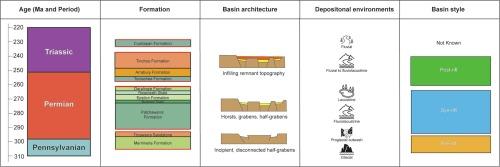澳大利亚东部库珀盆地宾夕法尼亚晚期至三叠纪早期失败裂谷系统剖面图
IF 7.2
1区 地球科学
Q1 GEOSCIENCES, MULTIDISCIPLINARY
引用次数: 0
摘要
澳大利亚东部的陆上地壳内库珀盆地发育于宾夕法尼亚晚期至三叠纪中期,位于泛大陆冈瓦纳地区约 50°S 的古纬度上。尽管有丰富的数据,包括钻探了 4,800 多个钻孔,但人们对库珀盆地的起源和演化仍知之甚少。为了更好地了解该盆地的地质历史,我们整合了遗留数据集,包括复合二维地震剖面图、测井记录、实测剖面图以及盆地西部的一维埋藏史模型,以重新解释该盆地的构造和沉积演化。对地震剖面的解释和计算的沉降速率表明,早期为活跃的裂谷阶段,有地堑和半地堑,在二叠纪晚期过渡到区域下陷阶段。构造样式的演变在很大程度上影响了盆地填充物的古地理演变以及由此产生的沉积结构。盆地的沉积物完全是陆相沉积,其面貌反映了从宾夕法尼亚晚期的冰川环境向三叠纪早期的温暖干燥环境的过渡。在二叠纪的大部分时间里,盆地填埋不足,相对较少的河道沉积物涌入跟不上容纳性的形成,从而形成了广泛的沼泽和湖泊系统。煤层厚达 30 米。相比之下,盆地在二叠纪晚期至三叠纪期间似乎被过度填充,河流沿着盆地的中轴线流淌。库珀盆地、东冈瓦纳内部裂谷和东澳大利亚裂谷等断裂系统的断裂开始、断裂结束和下陷阶段开始的同步性,有力地说明了在晚彭西凡尼世至中三叠世期间,整个大陆的延伸与板块运动的重大变化有关。本文章由计算机程序翻译,如有差异,请以英文原文为准。

Anatomy of the late Pennsylvanian to early Triassic failed rift system of the Cooper Basin, eastern Australia
The onshore intracratonic Cooper Basin of eastern Australia developed during the Late Pennsylvanian to Middle Triassic periods at paleolatitudes of approximately 50°S within the Gondwanan sector of Pangea. Despite the wealth of data available, including the drilling of over 4,800 boreholes, there is limited knowledge about the Cooper Basin’s origins and evolution. To better understand the basin’s geological history, legacy data sets, including composite 2D seismic sections, well logs, measured sections, and 1D burial history models from the west of the basin, are integrated to reinterpret the basin’s tectonic and sedimentary evolution. Interpretation of the seismic sections and calculated subsidence rates indicates an earlier active rift phase with grabens and half-grabens that transitioned, in the latest Permian, into a regional sag phase. The evolution of tectonic styles heavily influenced the paleogeographic evolution of the basin fill and resulting depositional architecture. The basin sediments are entirely terrestrial in nature and facies reflect a transition from glacial environments in the late Pennsylvanian to warmer and drier conditions in the early Triassic. During much of the Permian the basin was underfilled and the relative low influx of fluvial sediment did not keep pace with creation of accommodation, allowing the development of extensive mire and lake systems. Coal beds are up to 30 m thick. By contrast, the basin appears to have been overfilled during the latest Permian to Triassic with rivers flowing along the central axis of the basin. The synchroneity of commencement of rifting, termination of rifting, and commencement of a sag phase within the failed rift systems of the Cooper Basin, the East Gondwana Interior Rift, and the East Australian Rift strongly suggests a continent-wide period of extension related to significant changes in plate motions during the Late Pennsylvanian to Middle Triassic.
求助全文
通过发布文献求助,成功后即可免费获取论文全文。
去求助
来源期刊

Gondwana Research
地学-地球科学综合
CiteScore
12.90
自引率
6.60%
发文量
298
审稿时长
65 days
期刊介绍:
Gondwana Research (GR) is an International Journal aimed to promote high quality research publications on all topics related to solid Earth, particularly with reference to the origin and evolution of continents, continental assemblies and their resources. GR is an "all earth science" journal with no restrictions on geological time, terrane or theme and covers a wide spectrum of topics in geosciences such as geology, geomorphology, palaeontology, structure, petrology, geochemistry, stable isotopes, geochronology, economic geology, exploration geology, engineering geology, geophysics, and environmental geology among other themes, and provides an appropriate forum to integrate studies from different disciplines and different terrains. In addition to regular articles and thematic issues, the journal invites high profile state-of-the-art reviews on thrust area topics for its column, ''GR FOCUS''. Focus articles include short biographies and photographs of the authors. Short articles (within ten printed pages) for rapid publication reporting important discoveries or innovative models of global interest will be considered under the category ''GR LETTERS''.
 求助内容:
求助内容: 应助结果提醒方式:
应助结果提醒方式:


